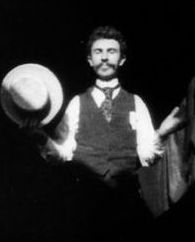
William Kennedy Laurie Dickson was a British inventor who devised an early motion picture camera under the employment of Thomas Edison.

Stereoscopy is a technique for creating or enhancing the illusion of depth in an image by means of stereopsis for binocular vision. The word stereoscopy derives from Greek στερεός (stereos) 'firm, solid', and σκοπέω (skopeō) 'to look, to see'. Any stereoscopic image is called a stereogram. Originally, stereogram referred to a pair of stereo images which could be viewed using a stereoscope.
3D films are motion pictures made to give an illusion of three-dimensional solidity, usually with the help of special glasses worn by viewers. They have existed in some form since 1915, but had been largely relegated to a niche in the motion picture industry because of the costly hardware and processes required to produce and display a 3D film, and the lack of a standardized format for all segments of the entertainment business. Nonetheless, 3D films were prominently featured in the 1950s in American cinema, and later experienced a worldwide resurgence in the 1980s and 1990s driven by IMAX high-end theaters and Disney-themed venues. 3D films became increasingly successful throughout the 2000s, peaking with the success of 3D presentations of Avatar in December 2009, after which 3D films again decreased in popularity. Certain directors have also taken more experimental approaches to 3D filmmaking, most notably celebrated auteur Jean-Luc Godard in his film Goodbye to Language.

A stereoscope is a device for viewing a stereoscopic pair of separate images, depicting left-eye and right-eye views of the same scene, as a single three-dimensional image.
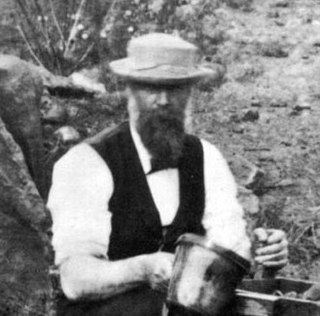
Carleton E. Watkins (1829–1916) was an American photographer of the 19th century. Born in New York, he moved to California and quickly became interested in photography. He focused mainly on landscape photography, and Yosemite Valley was a favorite subject of his. His photographs of the valley significantly influenced the United States Congress' decision to preserve it as a National Park.

Chronophotography is a photographic technique from the Victorian era which captures a number of phases of movements. The best known chronophotography works were mostly intended for the scientific study of locomotion, to discover practical information for animal handlers and/or as reference material for artists. Although many results were not intended to be exhibited as moving pictures, there is much overlap with the more or less simultaneous quest to register and exhibit photographic motion pictures.
Random-dot stereogram (RDS) is stereo pair of images of random dots which, when viewed with the aid of a stereoscope, or with the eyes focused on a point in front of or behind the images, produces a sensation of depth, with objects appearing to be in front of or behind the display level.
Stereopsis is the component of depth perception retrieved through binocular vision. Stereopsis is not the only contributor to depth perception, but it is a major one. Binocular vision happens because each eye receives a different image because they are in slightly different positions on one's head. These positional differences are referred to as "horizontal disparities" or, more generally, "binocular disparities". Disparities are processed in the visual cortex of the brain to yield depth perception. While binocular disparities are naturally present when viewing a real three-dimensional scene with two eyes, they can also be simulated by artificially presenting two different images separately to each eye using a method called stereoscopy. The perception of depth in such cases is also referred to as "stereoscopic depth".

Precursors of film are concepts and devices that have much in common with the later art and techniques of cinema.
The South Orange-Maplewood School District is a regional public school district, serving students in pre-kindergarten through twelfth grade from the suburban communities of South Orange and Maplewood, two municipalities in Essex County, New Jersey, United States.
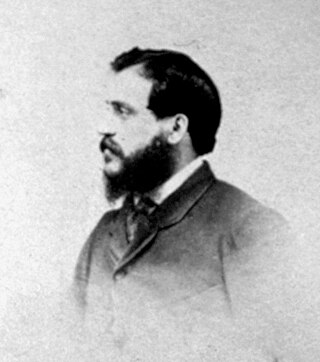
Felice Beato, also known as Felix Beato, was an Italian–British photographer. He was one of the first people to take photographs in East Asia and one of the first war photographers. He is noted for his genre works, portraits, and views and panoramas of the architecture and landscapes of Asia and the Mediterranean region. Beato's travels gave him the opportunity to create images of countries, people, and events that were unfamiliar and remote to most people in Europe and North America. His work provides images of such events as the Indian Rebellion of 1857 and the Second Opium War, and represents the first substantial body of photojournalism. He influenced other photographers, and his influence in Japan, where he taught and worked with numerous other photographers and artists, was particularly deep and lasting.

The Dragon Throne was the throne of the Emperor of China. As the dragon was the emblem of divine imperial power, the throne of the Emperor was known as the Dragon Throne. The term can refer to very specific seating, as in the special seating in various structures in the Forbidden City of Beijing or in the palaces of the Old Summer Palace. Metonymically, "the Dragon Throne" can also refer to the Chinese sovereign and to the Chinese monarchy itself. The Daoguang Emperor is said to have referred to his throne as "the divine utensil."
Underwood & Underwood was a producer and distributor of stereoscopic and other photographic images, and later was a pioneer in the field of news bureau photography.
The Keystone View Company was a major distributor of stereographic images, and was located in Meadville, Pennsylvania. From 1892 through 1963 Keystone produced and distributed both educational and comic/sentimental stereoviews, and stereoscopes. By 1905 it was the world's largest stereographic company. In 1963 Department A and the Education Departments were closed down, but Keystone continued to manufacture eye-training stereographic products as a subsidiary of Mast Development Company. In 1972 Mast closed the Meadville manufacturing site.

William Pumphrey was an early photographer based in York.
Thomas Richard Williams was a British professional photographer and one of the pioneers of stereoscopy.

Benjamin West Kilburn was an American photographer and stereoscopic view publisher famous for his landscape images of the nascent American and Canadian state, provincial, and national parks and his visual record of the great migrations at the end of the nineteenth century. Kilburn was a legislator in the New Hampshire General Court. A patent was granted for his gun-style camera.
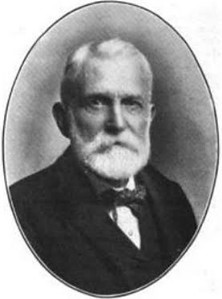
Edward Bierstadt was a photographer of portraits and landscapes as well as an engraver and a pioneer of color photography in the United States.
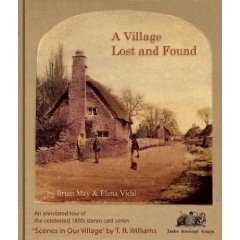
A Village Lost and Found: Scenes in Our Village by T. R. Williams is the full title of a book released in 2009 by Brian May and Elena Vidal. The book is an annotated collection of stereoscopic photographs taken by the Victorian era photographer T. R. Williams. It is sold with an OWL focussing stereoscope designed by Dr. May.

George Barker was a Canadian-American photographer best known for his photographs of Niagara Falls.















